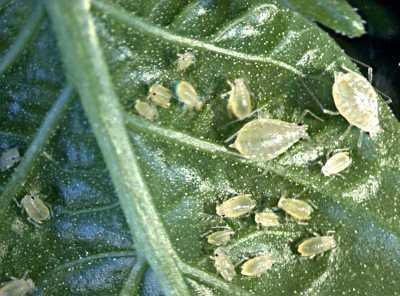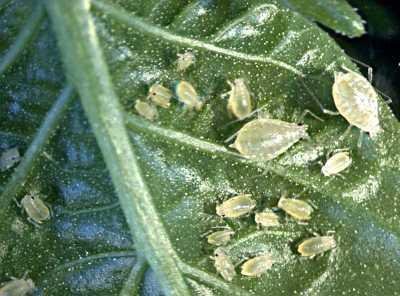

Main aphids in Africa: Black bean aphid ([i]Aphis fabae[/i]), Cabbage aphid ([i]Brevycoryne brassicae/Myzus persicae[/i]), Groundnut aphid ([i]A.craccivora[/i]), Cotton aphid ([i]A.gossypii[/i]), Russian wheat aphid ([i]Diuraphis noxia[/i]), Cypress aphid ([i]Cinara cupressi[/i])
Aphids (Myzus persicae, Macrosiphum euphorbiae, Aulacorthum solani, Aphis gossypii)
Many aphid species attack potatoes. The most important are the green peach aphid (Myzus persicae) the potato aphids (Macrosiphum euphorbiae, Aulacorthum solani) and the cotton aphid (Aphis gossypii).
Aphids are mainly found on young shoots on the underside of leaves. Feeding by aphids causes irregular curling of young potato leaflets and hinders growth of the leaflet. Potato aphids can also attack potato sprouts in stores.
Direct damage caused by aphids sucking sap from the plant is usually of little importance. Most damage is caused by honeydew production on foliage and virus transmission.
Aphids are important pests as vectors of potato viruses such as the Potato Leaf Roll Virus, a serious disease affecting potatoes. Seed potatoes are particularly susceptible to this virus and even low aphid populations can be very damaging.
- Conserve natural enemies. They are important in natural control of aphids. (Link to natural enemies datasheet).
- Control aphids in potato planted for seed production.
- Site seed production areas in locations with low temperature, abundant rainfall and high wind velocity. Aphid populations are generally low under these conditions.
- Within a potato growing area, locate seed potato fields upwind from commercial potato fields and alternative host crops to reduce dissemination of viruses through aphids carrying viruses.
- Keep seed production areas separated from commercial potato production.
- Check the field regularly. Monitoring of aphid build-up is important.
- Protect young plants from aphid attack. Virus spread early in the season is more serious than later on, as young plants are generally more susceptible. Moreover, plants that are infected early become more efficient sources for further virus spread than plants infected later in the season.
- Harvest seed potatoes no later than 8 to 10 days after a critical aphid build-up or increased virus infection rates are noted. This may help to avoid infection since the virus requires time to infect the tubers after a virus-carrying aphid has fed on potato foliage.
- Remove yellow flowering weeds and any other host plants within and around the field. Aphids are attracted to yellow colour.
- Protect potato tubers during storage by preventing access of aphids. Potato aphids readily colonise tuber sprouts. Seed potatoes are very susceptible to infection at this stage.
- Neem products are useful for reducing aphid populations on potatoes. In Sudan, 2 applications of seed extracts at a rate of 1kg seed kernels/40l water at a 14 days interval reduced aphid (A. gossypii) population to 60% compared to the control (Zebitz, 1995).
- Extracts of the weed Artemisia vulgaris have also shown toxicity to potato aphids (Metspalu and Hiiesar, 1994).
